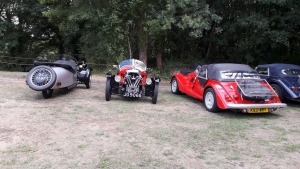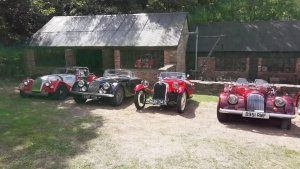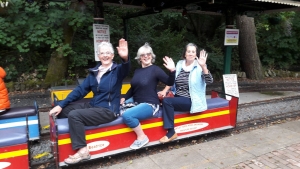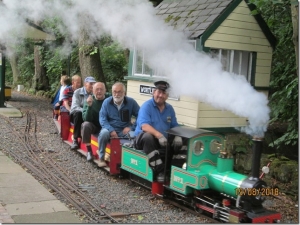Words and pictures by Heather and Eric Eadon
This one was something of an experiment. In recent years most of our outings have been during the week, however, this one was on Sunday principally because the forge is only open on weekends and was also a joint run with the local section of the 4 Wheeler Club. Happily both ideas appear to work and there was plenty of discussion between the 2 sides and not even one punch-up! Thank you Jon and Pauline Mark for your liaison between the 2 groups.
Before noon Pauline and I had greeted a variety of 3 and 4 wheelers and assorted tin-tops. The 8, 4 Wheelers included ‘Plus 4s’, ‘Plus 8s’ and ‘Roadsters’ (V6 Ford, ooops sorry Jaguar engines!), and slightly outnumbered the 7 Three Wheelers which were, Tom Cowley’s SV Blackburn 2 Speeder, the 4, 3 Speeder twins of Terry Cowley (MX4 Super Sports), John Snell (OHV WC Matchless Sports), Mick Barraclough (MX4 Sports) he is not a member………yet! (if I ambush them for details in the Dr’s car park at least you could get on with getting their money dad!!! – Hx) and Brian Bellamy whose 1933 Beetleback with DTZ 1300cc dog eared JAP – anyone considering a DTZ should have a good look at this one. There were also the 2 ‘F Types’ of Terry Green, the 8hp, F4 goes everywhere, motorways, summer, winter, hail, rain, snow or blow and last but not at all least Pauline and Jon Mark’s 1950 F2 – a concourse winner at any show. Sadly no 5 Speeders were able to get there.
Gordon Parkinson, the forge group organiser did us proud with the neatly prepared dedicated car parking area close to the main building. This was both helpful to us and the other forge visitors who could view the Morgan ‘display’ and ask questions (let’s hope they still had time to get round the forge!!! – Hx). Guided tours of the forge were on offer and I believe most of our 25 or so visitors took advantage of.
The water wheel (4 I believe) powered works was formally founded around 1650, when the big Baron who owned the nearby Cannon Hall estate bought out all the individual ore miners and smelters and brought them together on the Wortley site. ‘Low Forge’, now just a few bricks, took the ore and used water wheel powered bellows to blast air into the furnaces to generate the required temperature to melt the iron from the ore which was then tapped into moulds to form very contaminated iron blocks called ‘pigs’. These pigs were then transported to ‘Top Forge’ to purify the iron and produce a finished forged product.
At Top Forge the pigs were again heated to white heat i.e. about 14000c, checked by judgement of the naked eye – no pyrometers at that time! And a number of them bashed (forged) together by a water powered trip hammer thus squeezing the molten slag out and leaving a useable less contaminated wrought iron billet which would then go on to be made into a final product.
Initially the batches and forgings were small but as technology advanced over time when it closed around 1910 the forge had just produced railway wagon axles about 4ft in length with diameters varying between 3” and 5” to be machined elsewhere. No doubt the invention of the Bessemer converter which produced a much cleaner product in much bigger batches and steam, electricity and petroleum power resulted in the forge’s demise.
For me as an engineer beauty of the site is that all the load-bearing structures, cranes, hammers, waterwheels, shafts etc are made from large tree trunks, no costly high position assemblies, fine fits and position been attained by the use of small forged iron housings positioned with wooden taper wedges, no doubt they can be adjusted according to wear and weather – a lost art!
The current custodians, all volunteers, took the site over in the 1950s and should be very proud of their efforts having transformed a derelict shambles which I saw when I first went in the early 60s to today’s marvellous display.
Another feature of the site is a multi-gauge miniature railway run by the local model engineering society which runs round the site by the side of the forge’s energy supplying stream. It has a very impressive curved tunnel which no doubt thrills the young riders though I did see plenty of our ‘big kids’ taking a ride (there is photo evidence of you riding dad but the real challenge would have been to get a drive!! – Hx).
Several of our members arrived in Tin Tops complete with family members and there was also news of 2 almost completed rebuilds which now just require odds and sods and teething troubles ironing out. So members in Tin Tops, non-members in Morgans and families of all we look forward to seeing you at our regular pub meets and events in the future.
I must thank Steve Uprichard for his sterling work on the website, his advert for the run was seen by Joan Would who has been a previous member along with her husband and whose daughter is now showing an interest in Morgans (which you like job!). Joan made the trip from Lincolnshire to see us; friendships were rekindled and long chats ensued recalling many memories and names, some of whom are sadly long gone. Hopefully she will become regular attender at The Dusty Miller.
The run appeared to be a success for both groups, the weather behaved and the venue and site organisation were beyond fault. I don’t know yet when or where the next outing will be, but if you haven’t been to one make an effort next time a Morgan is not compulsory and all are welcome.




